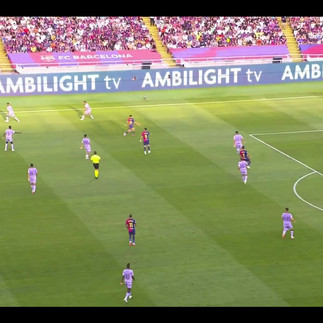Barcelona-Athletic Bilbao Match Analysis
- Bence Major
- 27 ago 2024
- 2 Min. de lectura
Actualizado: 20 sept 2024
First, let's take a look at Barcelona's starting lineup.:
Hansi Flick didn't cause any major surprises in his second match either. Before the game, the channels listed this as a 4-2-3-1 formation. Pedri was included in the starting lineup, which isn't surprising after his brilliant performance in the previous match.
Raphinha played the number ten role exceptionally well, even though Fermin Lopez returned.
There weren't many surprises in Athletic Bilbao's starting lineup either. Sancet, who later scored, played behind Inaki Williams, while Nico Williams started on the left. This was also listed as a 4-2-3-1, but for most of the match, it was a 4-4-2.
The match began with Barcelona dominating possession. In the first phase, Barca started with a relatively typical 4-1 or 4-2 build-up. Kounde and Balde positioned themselves relatively wide and deep. Raphinha tried to pick up the ball between the lines (defensive line-midfield).
As seen, Bilbao defended with a very compact 4-4-2. The task of the two strikers was to play very narrowly to prevent Bernal from receiving the ball. And they did this quite well. Bernal rarely managed to pick up the ball, which meant the central progression was mostly missing in the first half.
And if we look at the xG and the final result, we can see that Barca outplayed Bilbao. But it's not that simple. Most of the chances came from second balls after transitions or broken play. What I mean is that they didn't often advance with passes; instead, they collected loose balls or won throw-ins.
But if they did manage, how did they do it? With Raphinha positioned up front, this often looked like a 4-4-2 from Barca as well. Bilbao didn't take enough risks. While Lewandowski's drops were still followed by the center-backs (they stepped out aggressively on him), Raphinha often received the ball freely.
Remember Ferran's missed chance (which was later ruled offside)? That was the perfect example. Lewa drops back, lays it off to Raphinha, who then freely plays Ferran through (with a one-tempo delay). I said this after the Valencia match as well. The idea is good (one passer, one runner), but the execution was poor.
The other approach to breaking them down was to continuously create numerical superiority on the flanks. Kounde often pushed up to overlap behind Yamal. On the opposite side, Pedri frequently made runs between the center-back and the right-back (like in Lewa's goal).
But what was Bilbao's plan during counterattacks? Simple: Inaki Williams would drift wide, doubling up on the pulled-out center-back, especially when Kounde pushed up. However, what Barca did well throughout the match was finishing their plays. There were very few transitions.
Barca's pressing was very similar to the first match. Lewa and Raphinha marked the two holding midfielders, while Yamal and Ferran pressed the two center-backs.
Overall, Barca looked very good. But it didn't look perfect yet, especially the play with the ball in the 1st and 2nd phases.
Bilbao, on the other hand, played a rather weak match. Few chances from transitions, although their 4-4-2 mid-block looked solid...






















Comments